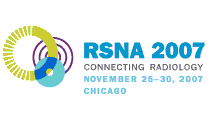
Abstract Archives of the RSNA, 2007
SSC20-05
Segmented Inversion Recovery TurboFLASH for the Assessment of Myocardial Infarction at 3 Tesla
Scientific Papers
Presented on November 26, 2007
Presented as part of SSC20: Cardiac (MR)
Armin Michael Huber MD, Presenter: Nothing to Disclose
Kerstin Ulrike Bauner MD, Abstract Co-Author: Nothing to Disclose
Olaf Muehling, Abstract Co-Author: Nothing to Disclose
Eva Winnik MD, Abstract Co-Author: Nothing to Disclose
Maximilian F. Reiser MD, Abstract Co-Author: Nothing to Disclose
Bernd J. Wintersperger MD, Abstract Co-Author: Nothing to Disclose
The aim of the study was to assess the diagnostic accuracy of imaging myocardial infarction with a segmented inversion recovery IR turboFLASH sequence at 3.0 Tesla in comparison to a segmented IR turboFLASH sequence at 1.5 Tesla.
15 patients with myocardial infarction were examined at a 1.5 Tesla MR System (Avanto, Siemens, Medical Solutions) and at a 3.0 Tesla MR system (TIM Trio, Siemens, Medical Solutions). Imaging delayed enhancement was started 15 minutes after application of contrast material. Images were acquired at 3.0 Tesla and at 1.5 Tesla with a segmented IR turboFLASH sequence with identical delay time and identical spatial resolution 1.3 mm x 1.8 mm x 8 mm. The IR turboFLASH sequence at 1.5 Tesla served as reference method. Infarct volumes, infarct areas on a selected slice position, transmural extent and CNR of infarcted and normal myocardium were compared at 1.5 Tesla and 3.0 Tesla.
The mean value of CNR between infarction and normal myocardium of the reference method at 1.5 Tesla was 6.4, the value for the IR turboFLASH sequence 3.0 Tesla was 14.1. The correlation coefficients of the infarct volumes, infarct areas and the transmural extent of the infarctions determined with the segmented IR turboFLASH at 1.5 Tesla and at 3.0 Tesla were r=0.95 (p = 0.0001), r=0.95 (p < 0.01) and r = 0.95 (p = 0.02), respectively.
The use of a higher field strength allows for an approximately twofold CNR increase without any loss of diagnostic accuracy concerning determination of infarct volume, infarct area and transmural extent.
Increase of CNR at 3T may allow to acquire images with an IR turboFLASH sequence with higher spatial resolution, parallel imaging and even as a single-shot technique with the use of a higher bandwidth
Huber, A,
Bauner, K,
Muehling, O,
Winnik, E,
Reiser, M,
Wintersperger, B,
Segmented Inversion Recovery TurboFLASH for the Assessment of Myocardial Infarction at 3 Tesla. Radiological Society of North America 2007 Scientific Assembly and Annual Meeting, November 25 - November 30, 2007 ,Chicago IL.
http://archive.rsna.org/2007/5009069.html

